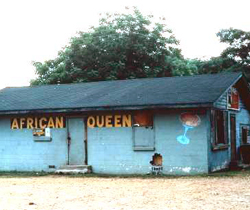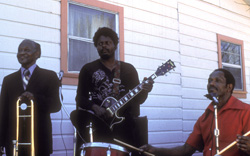Introduction to Delta Pieces: Northeast Louisiana Folklife
Map: Cultural Micro-Regions of the Delta, Northeast Louisiana

The Louisiana Delta: Land of Rivers








Ethnic Groups










Working in the Delta








Homemaking in the Delta




Worshiping in the Delta



Making Music in the Delta




Playing in the Delta







Telling Stories in the Delta



Delta Archival Materials
Bibliography


Nightclubs in the Delta
By Hiram Ford "Pete" Gregory, III
Editor's Note: In the early 1990s, Pete Gregory wrote these personal reflections about Northeast Louisiana's Delta and they are published with minimal editing. Also see his Musings on the Louisiana Delta from a Native Son.
In the late 1930s and through the 1940s, the Delta had "Night Clubs." These clubs had bartenders—real mixologists—and waiters dressed in starched white linen uniforms, coats, and ties. Dance floors were large, well polished hardwood, and the bandstand dominated the large halls. Tables were located around the floor, sometimes in alcoves along the sides. A large Wurlitzer dominated when the band did not play. On hot summer afternoons, people retreated to the clubs to drink gin fizz or whiskey sours, or sometimes tins of Jax beer. Children accompanied their parents, and the bartenders made them fizzes without gin, or lemonade with a maraschino cherry.
Attached to the bar, at least in the 1940s, was a gambling area. Dice tables, sometimes a roulette wheel, and several slot machines made these areas a busy place. Men and women played at the games. On Friday nights whole communities played Bingo. A chair near the bandstand belonged to the bouncer who carried a blackjack or a pistol, and who was usually a huge man capable of keeping or restoring order.
These clubs clustered in the Delta, especially near the bridges across the Mississippi River. People from Mississippi habitually crossed the river for their recreation, and the clubs were very popular places. Names like Bob's, Blue Heaven, Cool Coosa, and Casino Poco were arrayed in neon signs, complete with bubbling effects. Kids would sit and watch the simulated bubbles go around the neon fixtures, much as they stare at television now.
Then there was music! Black bands moved up and down the Delta from Memphis to Natchez and back. They came with brass, trumpets, a stand-up bass player, and always the set of snare drums. In the days of the "big band sound," white bands began to appear. The jitterbug replaced the waltzes and the two-step, but everyone danced. It was great music and nearly always a live performance.
Before air-conditioning, ceiling fans cooled the darkened halls and bars, offering people a constant refuge in summer. Young wives met in the afternoons for their equivalent to the cocktail hours of the cities—a time for Coca-Cola highballs, gin fizzes, and sours. Men met in the bars to drink a beer, or the more traditional double-shot of pure bourbon chased with cold water. The ritual life of white people in the Delta was tied to the clubs. Their owners were much respected in the communities and nobody thought them immoral or illegal. Periodically, people had fights at the nightclubs, and a few people were shot at dances, but mainly patrons were local people who knew one another and gatherings were social.
There were also clubs in the poorer sections of the Delta, like the black ghettos in the towns. Whites were not allowed in them, and they took their cues from the blues and jazzmen prowling from New Orleans to Chicago. The largest such black club in the region was Haney's Big House in Ferriday. It stretched along South Fourth Street (Highway 84) for nearly a city block. It abutted two competing bars and had its own bar, but dancing and bands were its forte. The owner, Will Haney, kept order; and though violence was present in the streets, it was soon expelled from the club. Black stars like Muddy Waters, B.B. King, Howling Wolf and others played at the Big House. It was the staging ground for local blues men: Hezekiah and the Houserockers, Pee-Wee Whitaker, and others perfected their style there. Hezekiah Early recalled sitting in the alley "playing drums" on a lard can with two sticks. A local drummer, a regular at Haney's, gave him a set of sticks and when the time was right, gave the boy set of drums. Next, Hezekiah played inside the club.1
White boys like Jerry Lee Lewis, Mickey Gilley, and the Reverend Jimmy Swaggart claim to have learned their country rock styles, at least in part, from listening to bands or blues men at Haney's. Their cousin married a man who ran a pharmacy and also sold records in the black section of Ferriday, so it was not hard for them to gain access to that part of town. Jimmy Swaggart's grandfather was town marshal and, in his old age, ran a used clothing store in the ghetto. Like Hezekiah, they had to listen from the alley behind the bar. Unlike Hezekiah, they never played the main stage inside. The rest of the black clubs, called "Jukes" or " Juke joints," were smaller, like their contemporary white equivalents. Some had jukeboxes or autophones. Most had an icebox and bar.
In Vidalia, planters paid their labor at Jim Cross' Bar and Grocery or Pat McDonough's Bar on Saturdays. Cross had a segregated set of bars under a single roof. A white owner paid a black bartender and watched over things from his "office," a cage in the front. The Cross "store" was dominated by a huge painting of the sun, smiling down from the ceiling with the motto, "What the Hell are you looking up here for?" Outside on the porch, men sold barbecue goat sandwiches, roasted peanuts, or tamales that came from barrels heated with charcoal. These rolled about on recycled wheels from baby strollers or tricycles scrounged from the community dumps.
Saturday nights, the black families came to town, collected pay, shopped, and had recreation. Whites stayed off the streets, and if they came to town to pay people, paid them and left. Sometimes younger white people sat in their cars and visited, but the dominant action in the towns was African American. The jukes rocked, and people jammed the stores and lonely streets. Elders of both races still recall the Saturday nights. There is a widespread story about the black man who told his white "boss man" that if whites could be black on Saturday night, he'd never want to be white again.
Shootings, sex, and the low moans of blind singers sitting on street corners are never going to reappear in the Delta. By the 1950s, all these things had changed. In the late 1930s and early 1940s, whites moving in from the hills of Macon Ridge or the backswamps brought new traditions. Country music, both secular and gospel, broke loose in the Delta. One by one, with the loss of legalized gambling, the white clubs closed. Haney's Big House burned in the early 1950s and the nightclub era of the 1930s and 1940s began to disappear.
Roadside bars and dance halls sprang up along the highways and the traditional violence of the backcountry transplanted itself there. They were marked with "No Minors" signs, country bands blared on Saturday nights, and people drank to fight. Anger replaced gentility and, often, sociability. Some, like the Arkansas Bar in Caldwell Parish, the "Bucket of Blood," or the 84 Club in Concordia Parish became fabled scenes of violence.

Similarly the small black "jukes"—places like the African Queen in Ferriday—carried on a blues, hard drinking, and fist-fighting tradition, and like their white counterparts, were less cosmopolitan than the early clubs.
By the 1950s, these traditions were coming together. A country music show on WMIS in Natchez, Mississippi, placed country sounds across the Delta. Arkansas Slim, the piano player/ disc jockey/country bandsman, daily introduced Hank Snow and the Nashville tradition to Delta performers.
Delta performers like Jerry Lee Lewis, Mickey Gilley, and Fred Carter crossed the Mississippi and followed Highway 61 north, through Mississippi, across their Delta, and on to Memphis. Memphis became a source of wealth, a Mecca for entertainers. They followed others, people selling illegal fish or whiskey, and the road was hard for everybody.




